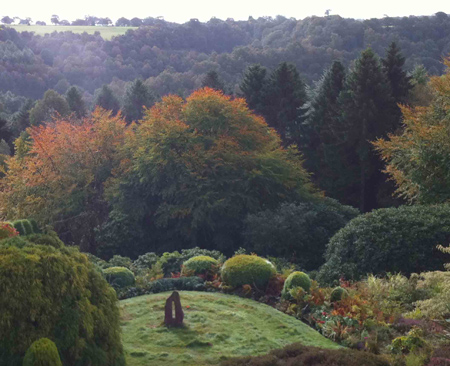

According to the Staffordshire Moorlands District Council, the Masterplan is a comprehensive plan which will provide a framework for future development in the Churnet Valley. It identifies opportunities to regenerate and manage this important rural area based on sustainable tourism in a sensitive manner which enhances the valley's important heritage, landscape and ecology. The Masterplan will have influence all future planning decisions affecting the area.
The Masterplan will cover the area identified as the Churnet Valley Tourism Corridor which follows the river Churnet from Tittesworth Reservoir and Rudyard Lake in the North West of the area, through Leek, Cheddleton and Froghall, linking to Cheadle, through to Oakamoor and Alton in the South East of the area.
Planning applications are now coming for developments at the Moneystone Quarry at Oakamor/Whiston and Boltons Copper Works site at Froghall. We need your support in objecting to these proposals.
Many of the points which informed the basis of our OBJECTIONS to the Master Plan proposals remain valid for objecting to specific planning applications:
The Masterplan contradicts David Cameron’s interview quote: “our vision is that we give communities much more say and much more control. Villages fear that a big housing estate will be plonked down. Our reforms will make it easier for communities to say we are not going to have the big plonking housing estate landing next to the village, but we would like say 10, 20, 30 extra houses and we would like them built in this way, we would like them” (BBC Television’s Country File Programme of 8 January 2012).
The Masterplan & the SMDC’s inaccessible ‘consultation’ process does not fully honour The Aarhus Convention (as of May 2013, it had been ratified by 45 states and the European Union) grants the public rights regarding access to information, public participation and access to justice, in governmental decision-making processes on matters concerning the local, national and transboundary environment).
The Masterplan contravenes many of the principles upheld in the Core Strategy.The Core Strategy is the policy which should be in place BEFORE the Masterplan is written. It determines the nature of what can and cannot be included. The original Core Strategy was rejected by the central government Inspector as it contained references to the developments of Alton Towers. Section SS7 RELATING to the Churnet Valley was required to be rewritten by the Inspector. It was sent out for re-writing along the lines indicated that would be acceptable to the Inspector. It has been modified and is awaiting final approval from the Inspector. It is now referred to This has been done and is referred to now as the emergent/revised Core Strategy it still awaits, formal adoption even as we approach the end of the premature Masterplan consultation period.
DETAILS OF THESE CONTRAVENTIONS AND OUR OBJECTIONS HERE.
We dispute the inclusion in the Masterplan of commercial developments and their expansion as the sole basis for the foundation for the future of the Churnet Valley. There is concern that the inclusions of developments for the major companies of Alton Towers, Laver Leisure and Stirling Investments act as a quasi-planning permissions. The developments ratified in the Masterplan would be seen as rubberstamped.
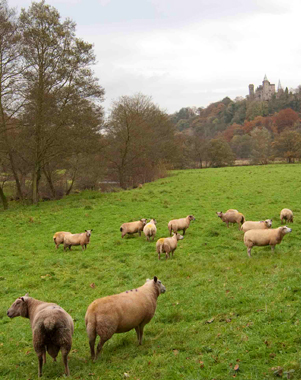
When the Earls of Shrewsbury acquired this site in the closing years of the eighteenth century, it was a rabbit warren and mainly treeless site. Over the next fifty years, successive earls developed the site into what became the largest landscaped gardens in Western Europe, and the house that was originally Alveton Lodge grew to become the largest country house in England.
This internationally important area has been recognised as such by English Heritage, as the house is a grade I listed structure, sitting within a scheduled ancient monument (Bunbury Hillfort), and surrounded by a conservation area and grade Ilisted gardens. The whole area contains in addition to this, many listed structures, and is still extremely picturesque.The garden buildings in their own right are an amazing collection - possibly the largest quantity of any formal garden in the country.
With all of this beauty and historical interest, this is the last place that one would expect to find a modern theme park, yet the local Council have allowed this to happen. Now roads are clogged, rides are noisy, and the clientele in the main know not and care not that they are in a beautiful part of the country.
Thrill seekers and country lovers are rarely good bedfellows. Yet these developments, deeply regrettable as they are, appear to be here to stay, and it has to be admitted thatmost of the white knuckle rides have been sited well away from the most sensitive areas.
The notable exception is Hex, which amazingly was allowed to be constructed within the walls of a grade I listed building, defiling the whole principle of protecting the ruins. The mansion house over the years has been plundered and pillaged for its wealth of architectural features and to allow such a development is nothing short of sheer sacrilege.
And yet this has all been allowed to happen in the name of business development and tourism needs.

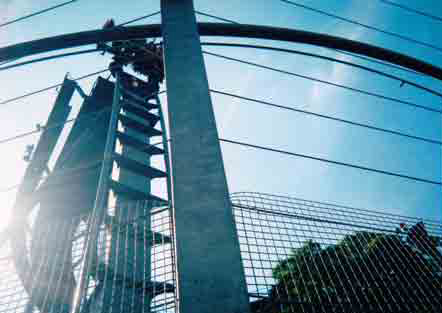
The LDF Core Strategy Submission Document in 2009, Policy SS7, includes the “sensitive expansion of Alton Towers.”
Meanwhile Alton Towers state that they want a world first, and that this new ride will be the most expensive to date. CVC ask exactly how ‘sensitive’ will this be, and how will it fit in with sustainable development. It is suspected that neither of these questions will be satisfactorily answered.
We have thus identified that to construct a theme park within an internationally important area is far from ideal. With this in mind, it is now important to reconnect the house and gardens with those who wish to visit them as a destination apart from the theme park. One way to achieve this goal is to section off the gardens and possibly the mansion house and charge a separate admission for these areas only.
Before the construction of Hex, it would
have been possible to include the mansion house in this area;
however, it must now be investigated whether it will be possible to
include the mansion house with one inevitable ride, or to include
this area within the theme park.
The ideal would be the former, with a planning caveat that when the ride reaches its natural end of life it be dismantled and the listed structure returned to its former glory. With the gardens and theme park segregated, funding could be applied for to begin to restore the garden buildings, most of which are in a sorry state. Once again, the gardens could be appreciated for what they are naturally, and planning permission in the future would be strictly outside the gardens and mansion house areas.
The LDF also states that there should be “the implementation of the Denstone and Alton Relief Road (part of the proposed route falls within the Moorlands) so that traffic through these areas associated with Alton Towers can be relieved.” CVC welcomes the opening of dialogue between SCC, Alton Towers, SMDC and ESBC.
Moorland and City Railways (MCR) now seem to be defunct. They had
been proposing a link to Stoke Railway Station with a reopened line
to Leekbrook , then to run over the Churnet Valley Railway line as
far as Moneystone, then reconstruct the former line to Alton
station.

What had been suggested is that instead of visitors driving directly to their destination at Alton Towers, they will drive to somewhere else (i.e. the park and ride), form a queue, board a railway train, ride to Alton, form another queue and board a shuttle bus to Alton Towers. It is quite plain that this is unlikely to happen, although excursion trains from large cities could be chartered. The section of line from Stoke to Alton Towers will be a private concern, serving neither the local resident nor the visitor to anywhere except Alton Towers. The proposal would also lead to an unacceptable impact on the Valley between Alton and Oakamoor which is visited by many people who enjoy the walking, cycling and horseriding on this quiet track.

The large numbers envisaged by Moorlands City Railways to support their sustainability argument would surely not to be able to be transported within the limitations of the daily timescale required by their customers for day visits to Alton Towers.
There would inevitably be peak periods during which they would want to arrive early in order to make the most of their time. Logistically there would be significant congestion at the pinch point of the current station steps and traffic converging by the corner of old mill and the lower lodge entrance.
Furthermore any new construction required to improve access from
there to the entrance to Alton Towers would entail major
engineering within the conservation area and have a detrimental
effect upon Abbey Wood.
CVC believes a rail line would adversely affect the Valley from Oakamoor to Alton and remains unconvinced that a rail link would help the local traffic problems as visitors staying within the region would not find it a convenient alternative. The development of new markets for visitors to the Towers from further afield via excursion specials is likely to be attractive to Alton Towers management. As this is new business it will not mitigate the existing severe road traffic problems but will increase noise and pollution caused by so many visitors to a relatively constrained site. However, CVC is aware that the rail proposal is an emotive issue for many and that there are some local residents who are in favour, notwithstanding the very strong opposition of most residents for the reasons given above.
Today it would appear that MCR's ambitions are largely fantasy.
Alton Towers management has publicly stated that they do
not believe their visitors have any interest in a long, slow
railway journey to their attraction. Cauldon Lowe cement
manufacturing is itself uncertain as to future ownership and the
investment required for a rail loading facility has
no economic appeal.

MCR have failed to obtain planning permission for a development at Leekbrook Junction and so have no funds to finance the connection to Leek. However this undertaking has been taken up by the Churnet Valley Railway (CVR) who have obtained significant funding towards the project. Development at Cornhill in Leek which would include a railway station has been given outline planning permission is still being promoted by the District Council.
MCR, with considerable assistance from CVR volunteers, did
re-open an 8 mile stretch of line between Leekbrook and
Cauldon Lowe. This has now been curtailed to only run as far as the
site of Ipstones Station and the track to Cauldon has been sold as
scrap to try and sustain the MCR plans. This section of line has
more recently been entirely taken over by the CVR. The ambition to
extend running to Endon has so far come to nothing.
Please let us know what you feel about this development:

This is a huge complex comprising disused industrial buildings and former buildings which have been cleared. A Masterplan for Bolton’s Copperworks at Froghall was commissioned by SMDC, who appointed Taylor Young as the consultants; this was produced in October 2010, and gives a complete picture of the site today, although many important aspects of the site were left unexplored. The survey states that the site is heavily contaminated but has failed to investigate further, it mentions sustainable connectivity but fails to list existing services, and crucially, it fails to reach any conclusions regarding how the site should be developed.
The Froghall site is centred upon the existing copper works adjacent to the A52. The factory is no longer operational and its future is uncertain, but any developments will need to address this issue.
The site at Froghall offers a number of opportunities and we have in this documentelaborated our view on possible developments here. If these proposals are implemented, all requirements for the development of the site will have been met, andthe outcome will provide genuine employment and visitor enjoyment.
Froghall is currently host to Bolton’s now defunct Copper Works, the terminus of the Caldon Canal and the Churnet Valley Railway, and a collection of industrial buildings surrounding the wharf and copper works.
Whilst most of the copper works’ site has recently been levelled and is extremely unattractive, the area surrounding the wharf has been landscaped withinterpretation boards, waymarked trails, and an adequate car park. It is maintained by the county council. There is much scope at Froghall for increased visitor facilities.
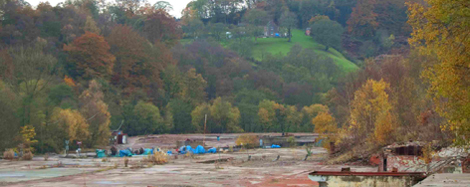
It is suggested that the area to the N and NW should be
returned to a greenfield site and traded in for the
development of the more lucrative sites to the north east and
south. Notwithstanding no prior knowledge of contamination,
this area is expected in any case to yield high quantities of
contaminated ground, so a cover of topsoil and a return to a
seminatural state might be the most appropriate solution.
Should a precedent be required for returning industrial sites
in the valley to greenfield, the Council needs to look no
further than Oakamoor, where in 1963 the former copper works
factory site was demolished and the area turned into a picnic
and open grassed area.
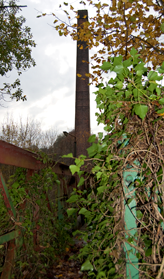

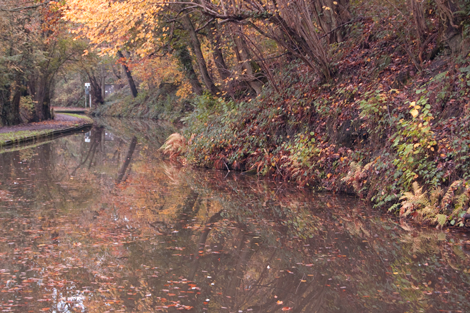
The second area to the north east towards Froghall Wharf is seen by the CVCS as the area most suitable for expansion. Bearing in mind that requirements are for sustainable tourism, the Baseline Report also cites the need for Froghall to be perceived as more of a‘destination’ for boaters along the canal, whilst appreciating that sustainable housing may not be appropriate due to lack of sustainable infrastructure. The CVCS can here put forward a solution that incorporates truly sustainable housing, sustainable tourism, retail, and at the same time provides a true destination for canal users.
Currently, Cottage Farm is lying derelict. It adjoins that site of the former Uttoxeter Canal, so any plan to develop this area should take into account the need to protect this line from unsuitable development. The proposal therefore is to restore lock no. 2 of the Uttoxeter Canal and a small section of the Uttoxeter Canal as far as the A52. A winding hole could then be provided adjacent to the A52 before the canal passes under the main road. This would be relatively easy to do, and would provide a backdrop to the development of cottage Farm. The outbuildings could be converted into a large courtyard of craft units facing into the courtyard, with adjoining dwellings for the craft workers to the rear. This would provide housing for the craft persons to live on site: a truly sustainable development, significantly the Caldon and Uttoxeter Canals Trust supports this measure.

It is believed that the Churnet Valley Railway would still like to have a locomotive workshop here. In terms of industry, this would appear to be totally in line with tourism related development, whilst as the same time affording local employment.
The Churnet Valley Railway also provides a tourist destination and appears to be generally accepted in the valley by local residents at this point. Any parts or completed locos would have direct access to the railway line and would therefore travel out of the valley by sustainable means.
Rail access to this site can be afforded by a branch line running alongside the protected line of the Uttoxeter Canal and joining the main line on the northern side of the river.
Please let us know what you feel about the development of the Botlon Copper Work:
This site is situated off a minor road between Whiston and Oakamoor, and until recently was owned by Sibelco, who quarried silica sand for the glass industry. Laver Leisure have since bought the site and announced plans to develop it which involved 640 log cabins, a 100 to 120 bedroom hotel, entertainment and leisure facilities on quite a large scale. There was considerable local opposition from residents and two surveys of Whiston and Oakamoor residents were almost unanimously against it. In particular there was much concern about the impact of a further 600+ cars a day at peak times on the local roads, particularly along Carr Bank as it is inevitable that many visitors to Moneystone will also wish to drive to AltonTowers. New plans have just been submitted by the developers scaling back on the number of lodges and with no hotels, but with a huge leisure hub for resident holidaymakers and day visitors, the massive overall impact is little changed.
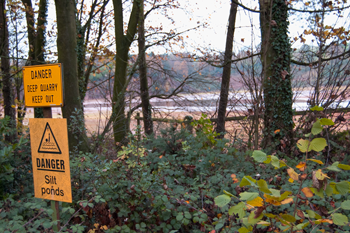

When mineral extraction rights were granted in the 1960s by Staffordshire County Council, it was on the condition that the land must be restored to a natural state when operations ceased. The local residents have lived with the noise and pollution of the quarry for half acentury, safe in the knowledge that the site would be fully restored when operations finished. Any infringement of this caveat should not be allowed and CVCs see this reinstatement as a prerequisite to any other development proposals.
Once the land has been restored to a natural state, and CVCs are happy to become involved in the decision making process regarding how this should be done, then the site must be reclassified as a green field site and included in the County Council’s landscape character assessment map as an area of high natural quality. With this new green field designation in mind, any future submission for planning permission will of necessity be limited to one that will be truly sustainable and one for which the local road infrastructure will be able to cope. The existing road system is wholly inadequate to support any major expansion of tourism activity on this site, moreover wholesale widening of the roads will be harmful to the environment.
Please see the Whiston Action Group for comprehensive information and updates on the Moneystone Quarry Development and follow "Say No to Moneystone Development" on Facebook
Please let us know what you feel about this development:
This is a 70 acre site on the edge of the valley. It has been developed over the last few decades, and could benefit from an increased awareness of its special qualities. The owner appears unable to maintain the gardens and a trust is thus proposed to manage affairs. Log chalets are thus proposed in order to raise funds for the gardens.
However, road access is narrow and already overloaded with visitors to Consall Nature Park and The Black Lion public house; it is difficult to perceive that more road traffic would be beneficial for the area. The alternative is a sustainable link in the valley bottom, although it is a long and arduous uphill walk from the station to the gardens; also at present the station is merely a small halt on the Churnet Valley steam railway and new passenger services through to Alton Towers are unlikely to wish to use this station.
It is difficult to conceive how a managed growth of Consall Hall Gardens or the provision of tourist accommodation could take place. Indeed this site has been deleted from the Masterplan.
